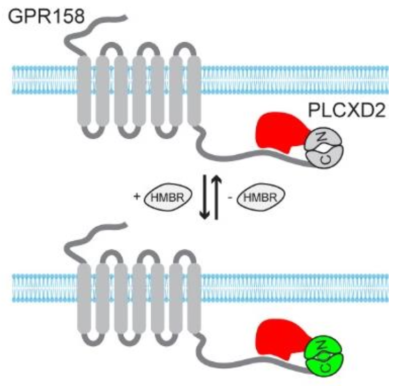A team led by Prof. Joris De Wit of KU Leuven has just elucidated the role of a special GPCR in dendritic spine maturation with splitFAST of The Twinkle Factory.
Synapses, the junctions connecting neurons into neural circuits, are most diverse, morphologically, molecularly. Yet, their diversity is known to play a key role in circuit connectivity, plasticity and vulnerability in disease. At the organelle level, a striking example is the spine apparatus (SA), which is found in a small fraction of dendritic spines. This unique organelle consists of stacks of endoplasmic reticulum (ER) cisternae that are connected to the tubular ER network in dendritic shafts. The SA preferably associates with large, mature dendritic spines. It plays a key role in postsynaptic development and has been implicated in various neurological disorders. However, the molecular mechanisms that dictate SA localization at selected synapses remain elusive.
The ER dynamically enters and exits dendritic spines, visits that are typically transient. Only in dendritic spines where the ER has been stably inserted for hours will a SA develop. Interactions between ER-resident proteins and cell-surface proteins localized at the plasmic membrane are suspected to promote ER anchoring in dendritic spines.
The Belgian team has identified a postsynaptic signaling complex comprising the GPCR-like receptor GPR158 and the poorly known phospholipase PLCXD2 that controls SA abundance. Indeed they have showed by means of sparse genetic manipulations that in the absence of GPR158, unrestrained PLCXD2 impedes postsynaptic SA incorporation and hampers dendritic spine maturation. Besides, they have identified the extracellular heparan sulfateproteoglycan (HSPG) which binding modulates the GPR158-PLCXD2 interaction. Interestingly, splitFAST, the split fluorescent reporter of The Twinkle Factory, was instrumental in this work. Indeed, it allows monitoring the GPR158-PLCXD2 assembly. But, unlike conventional systems, splitFAST fluorescence is reversible and vanishes upon complex disassembly, hence allowing for back and forth dynamic observations.
The Twinkle Factory supplies a whole range of fluorogenic reporters for splitFAST, varying in colors and affinity. The study reported above implemented the green HMBR or tfLime. Aso available are the red tfCoral or the far-red tfPoppy. Coming soon infra-red! Stay tuned!!!
Stain different. Tag FAST!
More reading
Verpoort, B., Amado, L., Vandensteen, J., Leysen, E., Dascenco, D., Vandenbempt, J., Lemmens, I., Wauman, J., Vennekens, K., Escamilla-Ayala, A. and Freitas, A.C.N., 2024. Cell-surface receptor-mediated regulation of synaptic organelle distribution controls dendritic spine maturation. bioRxiv, pp.2024-05. (https://doi.org/10.1101/2023.12.28.573515)

Recent Comments